Published by Pen & Sword in November 2021, this hardback book measures around 27.94 cm x 22.23 cm, has 208 pages and 250 colour & black and white illustrations and track layout maps. It has a published price of £30, and at the time of writing it can be bought online from Amazon for £23.00.
Starting with Charing Cross, the book has 15 chapters that describe London‘s present terminal stations.
Considering that “Historic” is part of the title, it has notable omissions such as Broad Street, which was the North London Railway’s terminus adjacent to Liverpool Street and closed in 1986, and Holborn Viaduct which was the London, Chatham and Dover Railway’s terminus in the City of London and closed in 1990.
At the beginning of the book is a sketch map that clearly shows how the stations are located around the periphery of the West End and the City of London. For some strange reason, the stations are not described in a logical sequence as on the map, but are covered haphazardly. For example, Chapter 1 which describes Charing Cross on the southern boundary of the West End, is followed by Chapter 2 which describes Euston on the northern boundary, then back to the southern boundary of the West End for Blackfriars in Chapter 3. The same illogical sequence continues throughout the book.
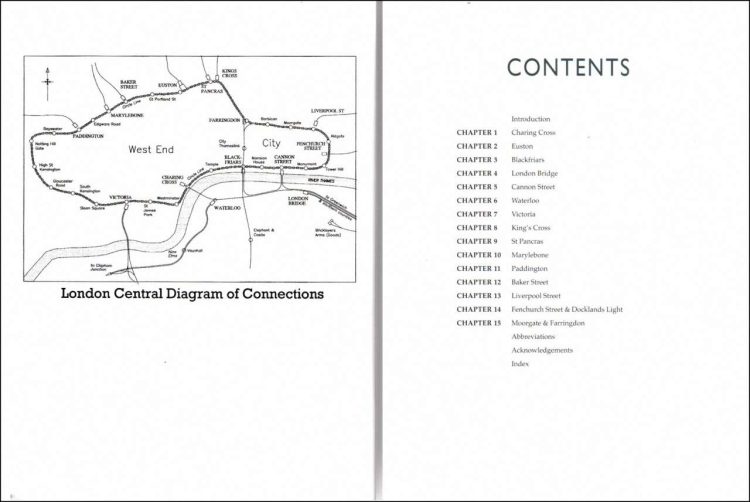
In the Victoria chapter the text states that “During World War I, it became the premier departing point for troops being shipped to France from Southampton”. In fact, trains for Southampton departed from Waterloo. A few paragraphs later we are told that “the old SR was still well short of having its system fully electrified, and a total of 999 new locomotives were built.” Here, the 999 locomotives referred to were the BR Standard classes that were allocated to all regions of British Railways, not just the Southern, which received just 115 of the new builds.
Most of the book’s illustrations are of stations and their surrounding infrastructure , with few photographs of trains within the stations. Many photographs that are included only have remote connections to the relevant station descriptions, such as the ones below taken from the Euston chapter, which show LMS Royal Scot, Princess Royal and Coronation class locomotives. Although those classes of locomotives did operate out of Euston, these photos are of preserved examples at locations many miles from Euston. The only photos of trains in the terminus are of a Class 378 electric multiple unit and three Pendolinos, with not a single photograph from the steam age or even the diesel era.
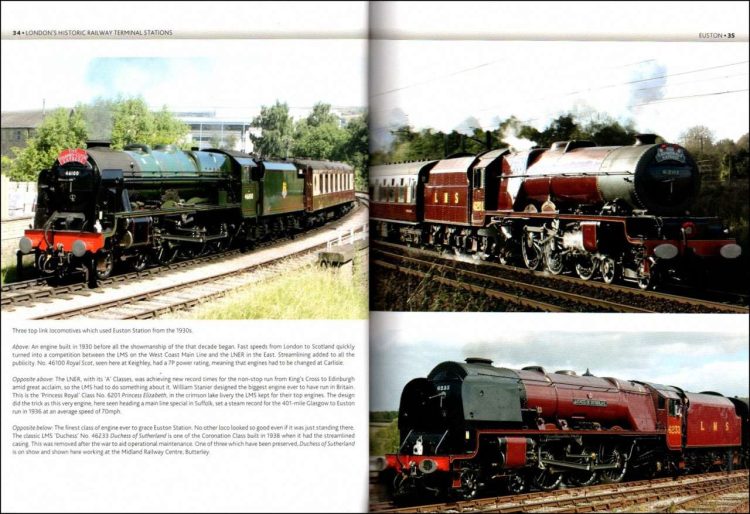
The photos below are taken from the King’s Cross chapter, and like Euston they are badly chosen. They include A4 Class Pacific Mallard at the National Railway Museum, an N2 0-6-2 tank engine at the North Norfolk Railway, and a Southern Region West Country Class Pacific in totally alien surroundings to its normal home of Waterloo, south of the Thames. It’s not only steam that suffers, as a photo showing two Deltic diesel locomotives, a class that graced the terminus in the 1960s and 1970s, was taken on the East Lancashire Railway.
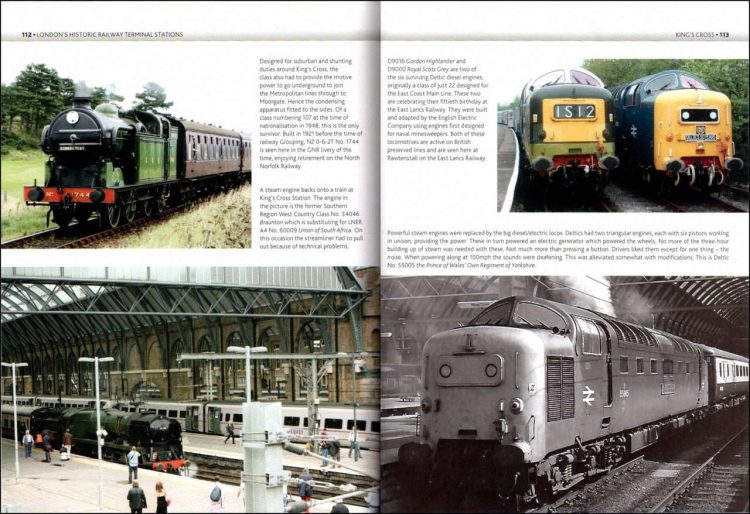
Adjacent to Kings Cross and the next chapter in the book is St. Pancras. Mainstays from the terminus in the age of steam were Stanier Class 5s and Jubilee Class 4-6-0s, as seen below. Both these photos were taken miles away from St. Pancras, at the North Yorkshire Moors Railway and Tyseley Locomotive Works respectively. On another page, the current scene is represented by a Eurostar next to a Class 125 HST, but the author’s reference to it being a domestic 437 left me perplexed. At the rear of the book and inexplicably in the Moorgate & Farringdon chapter is a fine illustration of the front of St. Pancras station before the Eurostar changes were made, but there is no reference to it in the St. Pancras chapter.
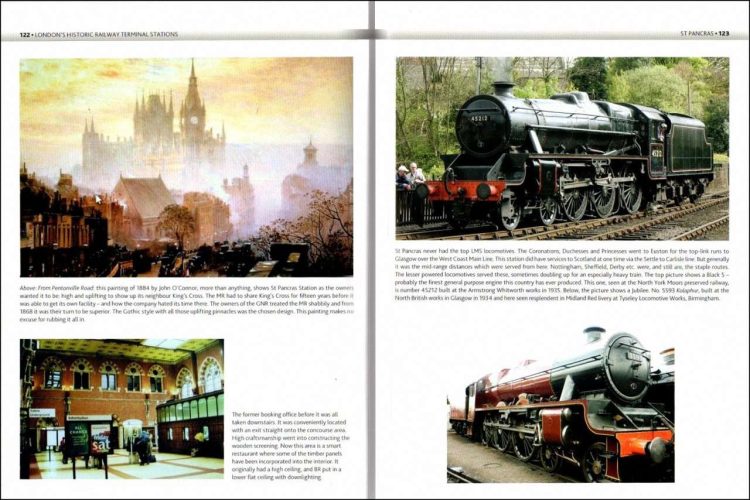
Paddington has more photos of trains than the other termini, but the selection is poor. For a station that was the preserve of Kings and Castles on its main line trains, the inclusion of a photo of an LNER A4 Class Pacific is not a good choice, neither is a King Class when it was taken at the Didcot Railway Centre, a Hall Class in a totally-alien ‘Hogwarts’ livery from J.K. Rowling’s Harry Potter books, or two Castle Class locomotives at Tyseley Works in Birmingham. A photo of Castle Class No. 5018 states that it was one of the engine class, which is an unknown class of locomotive. The same chapter also states that the fireman on the Cornish Riviera express would shovel two tons of coal into the King Class locomotive between London and Plymouth, when the true figure was nearer five tons.
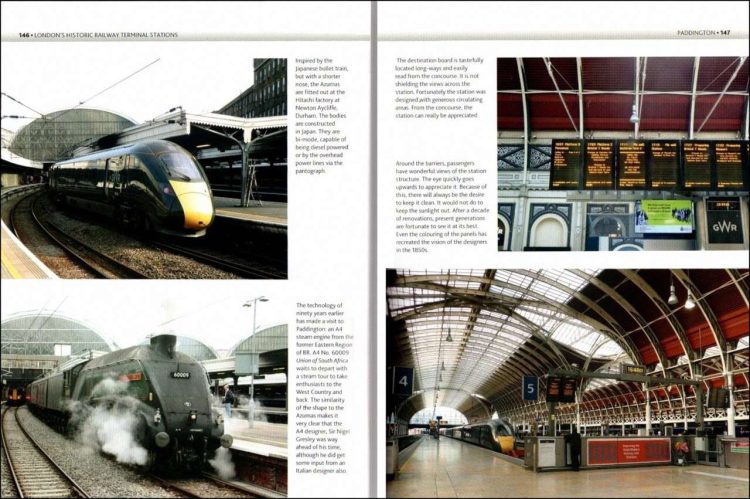
I was surprised to find a chapter on Baker Street until I read that it is a terminus of some Metropolitan Line trains as well as a through station. However, even though the station qualifies for inclusion in the book by being a terminus, the only photos of railways are of the through lines on London Underground’s Circle and District Lines.
The Liverpool Street chapter continues the theme of referring to unknown classes of locomotives such as a 900 class for a photo of a Class 90 electric locomotive, and a selection of ‘B’ class engines which are clearly B1 Class 4-6-0s. The sample pages below show an N7 class 0-6-2 tank engine which was the mainstay of suburban services out of Liverpool Street, but this example is totally out of place as it was taken on the North Norfolk Railway.
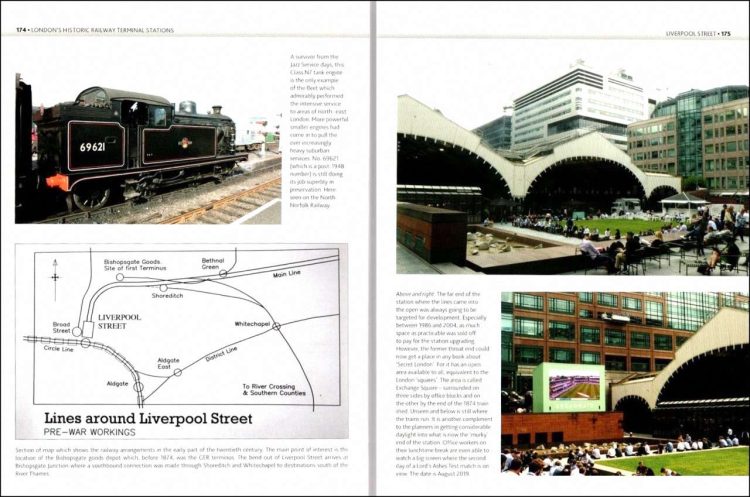
In the 1950s Britannia Class Pacifics were regulars on services from Liverpool Street to Norwich, but a caption tells us that many were allocated to this station. Liverpool Street station never had an allocation of locomotives as it was served by Stratford engine shed, and the Britannias serving Liverpool Street were allocated to Stratford and Norwich engine sheds.
Chapter 14 has a truncated title of Fenchurch Street and Dockland Light, which I assume the author meant to be the Docklands Light Railway that has its terminus at Tower Gateway next to Fenchurch Street station. However, as the book is concerned with London’s historic terminal stations, it seems odd to include it. The chapter itself is not immune from errors as it asserts that Riddles Standard Class 4s were added to the fleet in 1958, whereas 25 eventually ran on the line from when they were built from 1953 onwards.
My general impression of the book is that it should have been peer-reviewed before publication to eliminate obvious errors, of which the ones I have mentioned are just a few. Also, I would have preferred to see photographs of trains and locomotives in their original states in their appropriate stations, instead of in preserved condition somewhere miles away.
In summary, tLotso cover all London’s termini in a single book is quite a challenge, and there are plenty of photographs to support the descriptions. Unfortunately, in most cases there are scant details of how the stations evolved. The exception is Paddington, which has a timeline from 1835 to 2011, but still very little detail of its development and nothing at all about its Broad Gauge era. Major criticisms are the lack of photographs of trains in the stations, and the use of photographs taken on preserved lines instead of at the particular stations being discussed. I have already referred to various errors in the text, but sadly these are just a representative few.
The book is available to purchase from Amazon and from Pen & Sword.
We would like to thank Pen & Sword for providing RailAdvent with a copy of the book for review.






Responses